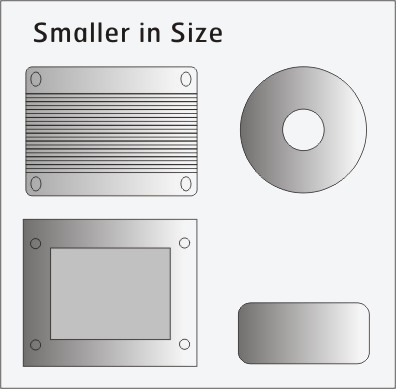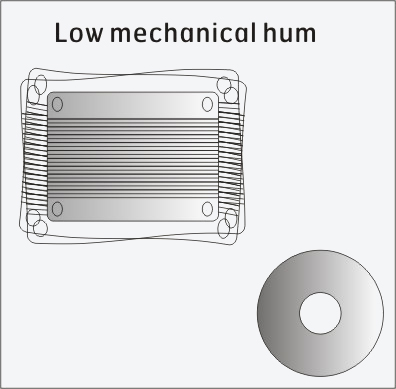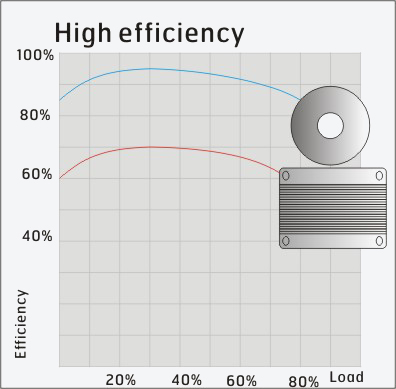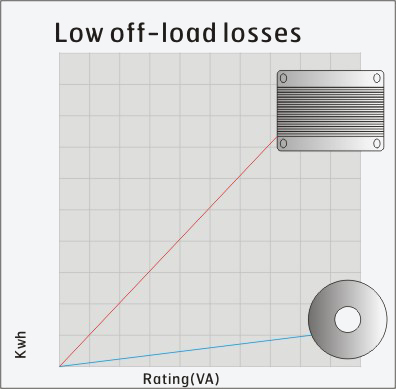In today’s time of smaller is better, the transformer is usually the largest component in any given circuit. Standard transformers are limited to how small we can make it as the size is proportional to the square root of the total transformer power. The laminated EI is the most common transformer core, but is not the only one that can be used. Using a toroidal, or donut-shaped core allows a reduction in the size and weight of a transformer by 20% to 50% compared with conventional cores without sacrificing performance. This is possible because core losses in toroids are typically 10% to 20% of the total power loss, with the balance being lost in the windings. Toroids are commonly used for current and instrument transformers, where low losses are extremely important. When comparing with conventional transformers where the core losses total 50% of the total power loss, the advantages are easily seen. Cooler operating temperatures and low magnetizing current are two of these advantages. Using the high permeability and low-loss characteristics of a modern transformer core have broadened the toroidal transformer design abilities. Other advantages are higher efficiency, lower operating temperature, and lower noise. With improved techniques and equipment, the toroidal transformer not only has many performance advantages it is also an affordable solution to modern requirements.
Advantages of the Toroidal (Ring, Donut-Shaped Core) Transformer:
- Nearly Ideal Magnetic Circuit
- Lower Stray Magnetic Field
- Less Volume and Weight
- Less Audible Hum
- Higher Efficiency (perfect for stray magnetic field sensitive circuitry)
An Ideal Magnetic Circuit
The EI cores structure in most common transformers makes it difficult to align the grain structure of the stamped laminations with the flux path over the entire magnetic path. With this comes higher core loss and less efficient operation compared to toroidal transformers. Figure 1 EI laminate grain alignment with flux path. Figure 2 for a toroidal core.
 
Low Stray Field
In laminated transformer the designs most commonly use a bobbin wound coil over a stack of "E" shaped laminations. "I" shaped laminations are stacked and butted up to the "E". This completes a magnetic path. A perfect fit between the E and I is impossible and this raises the discontinuity as there is a air gap in the path of the magnetic flux. A greater radiated magnetic field is caused by this gap as it has higher reluctance. The unpredictability of the properties of a gapped core inhibit exact design and spread needed allowable tolerances.
Also, discontinuity in the windings that surround the flux path of an EIcore transformer give rise to the leakage flux. The concentration of the windings in small regions of the laminates leaves large portions of the flux path exposed. This abrupt transition from windings to bare laminates creates an opportunity for the flux to escape the confinement of the core and form linkage paths outside the transformer. Winding transitions can also lead to high leakage inductances for the EIcore transformers.

Toroidal transformers do not have an air gap. The core is tightly wound onto a mandrel, like a clock spring, from a continuous strip of grain oriented electrical steel. It is then spot welded and annealed in a dry nitrogen atmosphere to prevent loosening and core loss. The result is a stable, predictable core, free from discontinuities, holes, clamps and gaps.
Reduced Weight and Size
Do to the high efficiency of toroidal transformers they be much smaller in weight and size compared to common laminated transformers. Toroidal transformers are about half the size and weight of standard transformers.

Less Audible Hum
Audible hum in transformers is caused by vibration of the windings and core layers due to forces between coil turns and core laminations. Clamps, bands, rivets, and welds cannot bind the entire structure. Varnish penetrates the laminations only partially. Laminations tend to loosen over time, producing increasing hum. The nature of the toroidal transformer’s construction helps to dampen acoustic noise. The core is tightly wound in clock spring fashion, spot welded, annealed and coated with epoxy resin.

Audible hum, heard immediately after application of power, may be noticeable in the toroid, and then die down to a quieter level a few seconds after power is applied. This is a result of the toroid’s greater inrush current.
Higher Efficiency
Efficiency of a transformer is stated as:
Efficiency = Pout / Pin
Where Pout is the useful output power delivered to the load, and Pin is the power input to the transformer. The difference between Pin and Pout is consumed by losses in the core and windings. The ideal magnetic circuit of the toroid, and the ability to run at higher flux density than EIlaminates, reduces the number of turns of wire required and/or the core cross sectional area. Either benefit reduces the losses. Toroidal transformers typically are 90 to 95 per cent efficient; whereas EIlaminates have a typical efficiency of less than 90 per cent.


In recent years, more attention is being given to energy efficiency of electrical equipment, and legislation has been considered which would encourage minimum efficiency standards for all types of electrical products, with lighting and computer equipment being the most prominent. The toroidal transformer will serve as a method for achieving compliance to these new energy efficiency standards.
A toroidal transformer does a better job of reducing those losses to their minimum practical values than any other production core form. |
